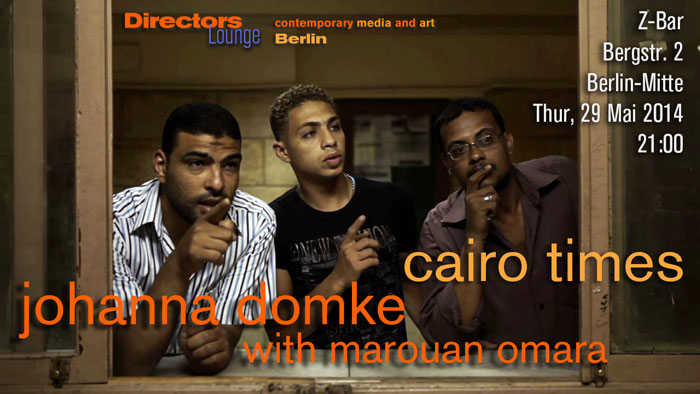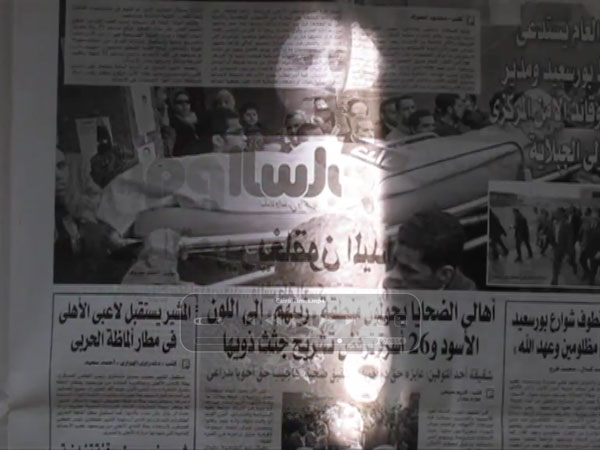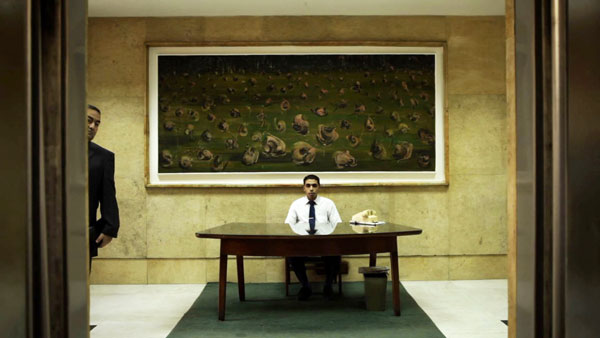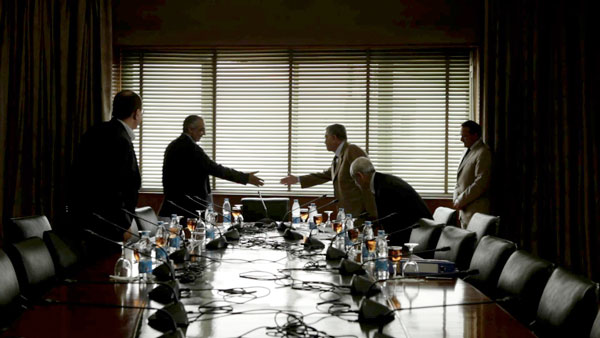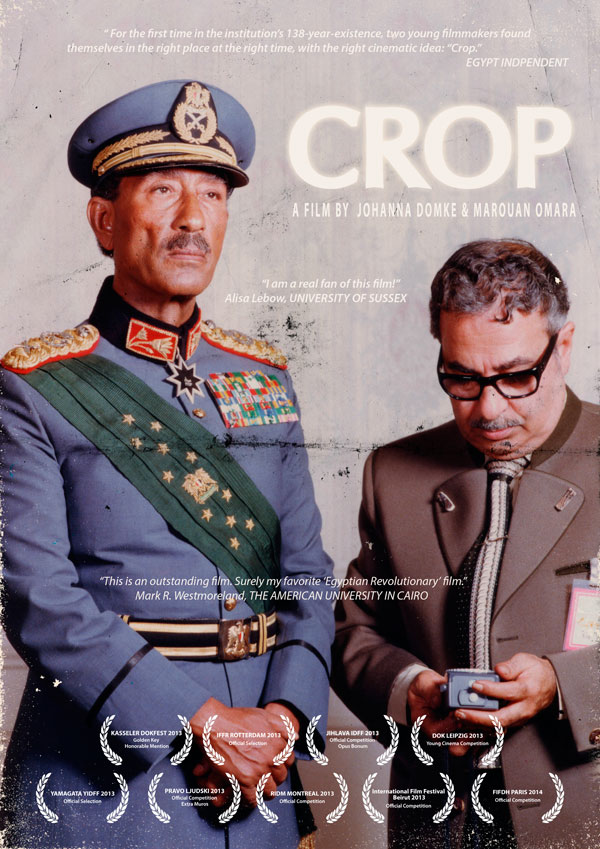directors lounge monthly screenings
johanna domke with marouan omara
cairo times
Crop ist ein erstaunlicher Film über ein Zeitungsgebäude im Zentrum von Kairo. 2012, ein Jahr nach dem Beginn der Revolution in Ägypten aufgenommen, repräsentiert der Film einen interessanten historischen Moment und ist zur gleichen Zeit eine Reflexion über das Bilder-Machen und Bilder-Repräsentieren während Zeiten politischer Umbrüche, unabhängig von temporären oder örtlichen Gebundenheiten.
Der Film spielt in dem Pressehaus von Al Ahram (Die Pyramiden) einer konservativen Zeitung und das staatliche Presseorgan aller Präsidenten seit Nasser. Der Zuschauer wird von oben nach unten durch das Haus geführt, in der hierarchischen Ordnung der Räume, von den repräsentativen Räumen bis hinunter in den Keller zu Druckmaschinen und Verpackung der Zeitungsbündel. Während sich vor der Kamera Schritt für Schritt die Komplexität der Räume entfaltet, spricht ein Fotojournalist über die Anfänge der Fotoreportage in Ägypten. Er erzählt uns, dass er die Revolution im Krankenhaus verpasst hat. Er spricht über die Beschränkungen, denen der Fotojournalismus von Anfang an unterlag, sowohl von Seiten der konservativen islamischen Gesellschaft als auch vom Regime, das jede Publikation kontrollierte und zugleich die Angst vor öffentlicher, journalistischer Fotografie schürte. Die Einheitlichkeit seiner Figur ist jedoch fiktiv. Seine Narration wurde tatsächlich aus 19 Aussagen unterschiedlicher Journalisten komponiert, die im Detail in komplexer Weise differieren. Der Ton des Filmes ist aus zwei Ebenen komponiert: Den Atmo-Sound, der den Durchgängen der Räume im Innern des Gebäude folgt, und andererseits der Voice-over des Interviewten. Dieses Voice-over erzeugt eine kontrapunktische Montage im Sinne Eisenstein's Thesen zum Tonfilm, während der atmosphärische Ton einen poetischen Fluss der Bilder generiert, eine Raumes-Erzählung.
Der Film, eine Co-Regie der Videokünstlerin Johanna Domke und des Regisseurs Marouan Omara, war auf mehrfache Weise aus einem glücklichen Moment entstanden. Domke hatte ihr Residenzstipendium schon vor der Arabischen Revolution geplant, und das Filmen selber, inklusive der Vorbereitungen und notwendigen Genehmigungen, war nur in dieser kurzen Zeit des Umbruches möglich, bevor das neue Regime die Kontrolle wieder an sich riss. Der Film repräsentiert daher eine einmalige Zeit in der Geschichte Ägyptens und auf der anderen Seite gibt er einen gut verständlichen Einblick darin, was es heißt als Journalist unter Zensurbedingungen zu arbeiten. Wie Johanna mir sagte, habe das Team jedes Mal gefragt, wo denn die Zensur stattgefunden habe, und sei immer auf eine andere Abteilung verwiesen worden. Es gab kein Zensurbüro oder -Abteilung, sie war einfach Teil des Systems als Ganzes. Auf bestimmte Weise ähnelt das im Film gezeigte Pressehaus dem Schloss von Kafka, wo sich die Gewalt in all den Räumen nie manifestiert. Beim Betrachten des Filmes kann einem das Gebäude und seine "Bewohner" allerdings zugleich auch unglaublich vertraut vorkommen, seine Unterteilungen, sein Poesie des Raumes, der Vertrautheit des bürokratischen Raumes. In der "Poetik des Raumes" spricht Gaston Bachelard über die Philosophie des Raumes indem er ein altes Familienhaus als Beispiel anführt. Etwas was ich immer als ungenügend zumindest in Bezug auf die Moderne empfunden habe, und in gewisser Weise kann der Film "Crop" das Bild der modernen Poetik des Raumes komplementieren.
Der erzählerische Eröffnungsszene des Filmes mit dem Journalisten, der im Krankenhaus die Revolution verpasst, könnte als Schlüsselszene für die Motivation des Filmes und die Interpretation seines Titels "Crop" (Beschnitt) angesehen werden. In diesem ersten Abschnitt berichtet uns der Erzähler auch von einem späterem Ereignis, als er die Kamera vor einer großen Menschenmenge aufbaute: "Ich wußte dies würde meine letzte Bild sein. Für immer." Der Film ist auch die Geschichte von der Unfähigkeit, in der Zeit des Umbruches, in Zeiten der Revolution aussagefähige Bilder aufzunehmen. In den Turbulenzen der Ereignisse fehlen dem Künstler, dem Fotografen, die Distanz um Sinn zu erzeugen. Der Journalist dagegen, der während der Revolution im Krankenhaus liegt, um von einem Herzinfarkt zu genesen, erreicht vielleicht diese Distanz um den Dingen Sinn zu geben. Oder zumindest genügend, um sich ein eigenes Bild zu machen. Dasselbe passierte Johanna Domke und Marouan Omara. Sie trafen in Cairo zusammen und stellten fest, dass sie etwas gemeinsam haben: das Gefühl, dass es vergeblich sei, den täglichen Bildern hinterher zu jagen. Das Projekt, das sie daraufhin gemeinsam begannen, gab ihnen dagegen die Möglichkeit zur Reflexion. Zuerst begannen sie mit Interviews von Fotojournalisten. Dann entstand das Filmprojekt über das Pressehaus mit all seinen Unterabteilungen. Zu dieser außerordentlichen Zeit war das Unternehmen dem ständigem Wandel unterworfen. Als offizielles staatliches Presseunternehmen, wie hat man sich zu positionieren? Und wie als Direktor, als Verleger oder als Redaktionsteam? Die Passagen, Flure und Räume, und auch die Narration über den Status der Photographie in Ägypten, beide wirken wie ein Filter, der eine bestimmte Distanz erzeugt. Er beschneidet (crop out) die Unmittelbarkeit der täglichen Nachrichten und erlaubt daher eine Vielfalt von Lesarten. Die Vergangenheit und die Gegenwart entfalten sich vor dem Zuschauer.
In ähnlicher Weise arbeitet "Cairo Times" mit einer Distanzierung zum Pressematerial, das präsentiert wird. In diesem zweiten Filmprojekt scannt Johann Domke die Zeitungen, die sie aus Kairo mitbrachte. Das Scannen selbst wird zur Aktion für die Kamera. Das Pressematerial mag für den Zuschauer lesbar oder nicht lesbar sein, je nachdem ob er Arabisch versteht, oder ob er Erinnerungen an die "Zeit des Tahrir Platzes" besitzt. Das Licht des Scanners "blutet" durch die Bilder, die dem Zuschauer präsentiert werden: eigentlich die Rückseiten der Scans. Gleichzeitig erzählt die Künstlerin selbst in einem dichten Gedanken und Erinnerungsstrom von ihrer Erfahrung in Kairo, während des ersten Jahrestages der Revolution. Und, über die Bedeutung der Fotos, die von Tausenden von Mobilkameras geschossen wurden, die auf dem Web und den Sozialen Netzwerken zirkulierten, die in lokalen und internationalen Medien gezeigt wurden.
Donnerstag, 29 May 2014
21:00
Z-Bar
Bergstraße 2
10115 Berlin-Mitte
Programm:
Cairo Times 12:23 min, 2013
Crop 47:08 min, 2012
Artist's Links:
http://www.johannadomke.net
Press Links:
Z-Bar - http://www.z-bar.de/
Directors Lounge
 Back Back
|
